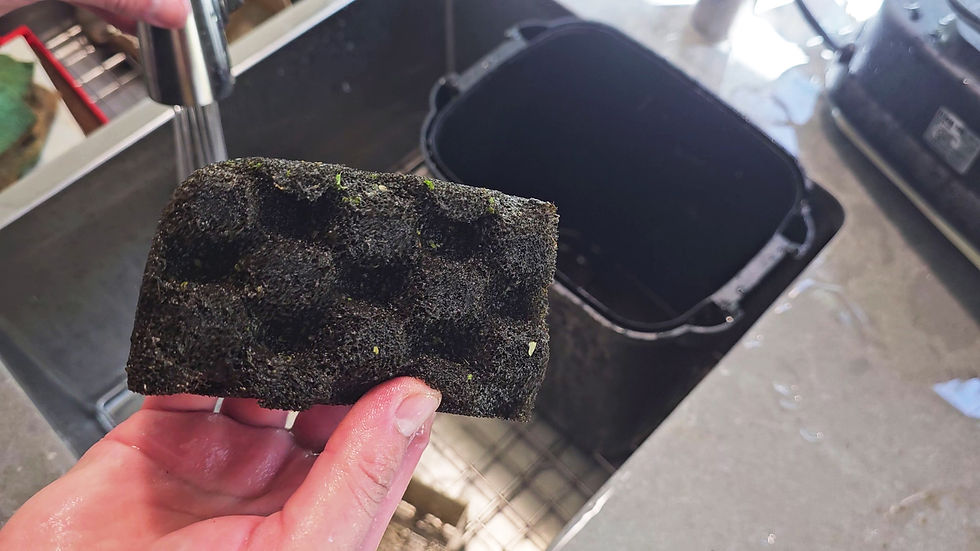Filter Cleaning Fears? What Science Says About Cleaning your Filter With Chlorinated Tap Water
- AquascapeGuide

- Aug 1
- 3 min read

As aquarists, we're all taught the golden rule: never clean your filter media with chlorinated tap water! The fear is that the chlorine will instantly wipe out your precious nitrifying bacteria, crashing your cycle and putting your fish at risk. It's a deeply ingrained belief, and for good reason – chlorine is a disinfectant.
But what if we told you that the beneficial bacteria responsible for your aquarium's nitrogen cycle might be a lot tougher than you think? A scientific study published in "Applied and Environmental Microbiology" sheds some fascinating light on just how resilient these microscopic workhorses are, even in the presence of disinfectants like chloramine, which is commonly found in tap water.
The Unsung Heroes: Nitrifying Bacteria in Treated Water
First, a quick reminder: nitrifying bacteria are essential for a healthy aquarium. They convert toxic ammonia (NH3) into less toxic nitrite (NO2−), and then convert nitrite into much safer nitrate (NO3−). This process, the nitrogen cycle, is the backbone of a stable tank.
The study investigated chloraminated water supplies in South Australia to understand the prevalence and resistance of these bacteria. What they found might surprise you:
Nitrifying bacteria were detected in a significant 64% of samples collected from chloraminated water supplies. Which means nutrifying is alive in well in systems that have chlorine in them.
Even more strikingly, they were found in 20.7% of samples that contained more than 5.0 mg of monochloramine per liter. This suggests a notable tolerance to disinfectant presence.
Surprisingly Resilient: What Lab Experiments Revealed
To delve deeper, laboratory experiments were conducted to assess the sensitivity of natural nitrifying bacteria populations to monochloramine (a common disinfectant in tap water, similar to chlorine in its intent). The results confirmed their relative resistance.
Consider this: based on the study's findings, it would take a whopping 760 minutes (over 12 hours!) to inactivate 99% of a natural population of nitrifying bacteria when exposed to an average dose of 1 mg of monochloramine per liter. This is a far cry from the instantaneous death many hobbyists imagine when a splash of tap water hits their filter media.
The researchers also noted that bacteria grown in a laboratory setting tend to be less resistant to disinfectants compared to natural populations. This implies that the nitrifying bacteria thriving in your established aquarium are likely even hardier than those studied in controlled lab conditions. Furthermore, bacteria often exist in protective biofilms and attach to surfaces, which can offer additional protection from disinfectants. The study also highlighted that the concentration of the disinfectant is more important than the exposure time for inactivation.

What This Means for Your Filter Cleaning Routine
So, what's the big takeaway for your aquarium maintenance? The science suggests that you don't need to be afraid of using regular tap water to rinse your filter media during routine cleaning. The beneficial nitrifying bacteria are much more resilient to the typical levels of disinfectants in tap water than often believed. A quick rinse under the tap to dislodge detritus is unlikely to wipe out your entire bacterial colony and crash your cycle. Most of the time we'll leave some aquarium water in the canister when we are cleaning it out. We will remove our mechanical filtration, rinse it well with tap water and then put it back into the tank water that is in the canister. Then we move to the biomedia and get that rinsed out, then put everythign back in and top off the canister with tap water. Lastly we'll add a small amount of dechlorinator to the canister water and hook it back up to the aquarium. Done and done.
This newfound understanding means you can potentially save time and effort by not needing to meticulously save tank water for filter cleaning every single time. Your cycle is much more robust than a momentary exposure to chlorinated water might suggest.
Want to watch us service our canister filter? Check out the video below!
Still Apprehensive? Play It Safe!
However, we understand that old habits (and the fear of a tank crash!) die hard. If you're still feeling apprehensive, there's absolutely no harm in sticking to your current routine. You can continue to use old tank water (siphoned out during your water change) to gently rinse your filter media. This method remains perfectly safe and effective for cleaning your filter without disturbing your bacterial colonies.
Ultimately, the goal is a clean filter and a healthy, stable aquarium. Knowing that your nitrifying bacteria are surprisingly robust can give you peace of mind, allowing you to choose the filter cleaning method that you're most comfortable with.
Sources:
Bacterial nitrification in chloraminated water supplies - https://journals.asm.org/doi/abs/10.1128/aem.57.11.3399-3402.1991
City of San Bernardino Municipal Water Department - https://www.sbmwd.org/ArchiveCenter/ViewFile/Item/81




Comments